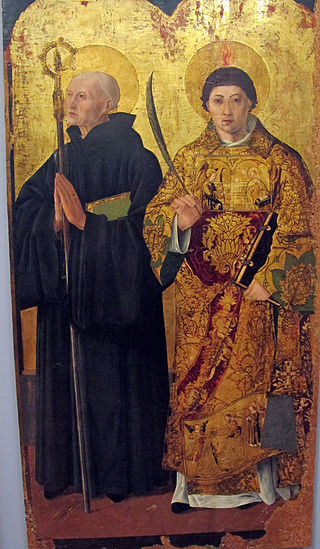Related Research Articles

Pope Sixtus II, also written as Pope Xystus II, was bishop of Rome from 31 August 257 until his death on 6 August 258. He was martyred along with seven deacons, including Lawrence of Rome, during the persecution of Christians by the Emperor Valerian.
Gavinus is a Christian saint who is greatly celebrated in Sardinia, Italy, as one of the Martyrs of Torres, along with his companions Protus, a bishop, and Januarius, a deacon.
Marcus Minucius Felix was one of the earliest of the Latin apologists for Christianity.

Januarius, also known as Januarius I of Benevento, was Bishop of Benevento and is a martyr and saint of the Catholic Church and the Eastern Orthodox Church. While no contemporary sources on his life are preserved, later sources and legends claim that he died during the Great Persecution, which ended with Diocletian's retirement in 305.

July 9 - Eastern Orthodox Church calendar - July 11

Nabor and Felix were Christian martyrs thought to have been killed during the Great Persecution under the Roman emperor Diocletian. A tomb in Milan is believed to contain their relics.
Saint Proculus (Proclus) of Pozzuoli was martyred around 305 AD, according to Christian tradition, at the same time as Saint Januarius.

The Naples Cathedral, or Cathedral of the Assumption of Mary, is a Roman Catholic cathedral, the main church of Naples, southern Italy, and the seat of the Archbishop of Naples. It is widely known as the Cathedral of Saint Januarius, in honour of the city's patron saint.

Felicitas of Rome, also anglicized as Felicity, is a saint numbered among the Christian martyrs. Apart from her name, the only thing known for certain about this martyr is that she was buried in the Cemetery of Maximus, on the Via Salaria on a 23 November. However, a legend presents her as the mother of the seven martyrs whose feast is celebrated on 10 July. The Eastern Orthodox Church celebrates their martyrdom on 25 January.

The Catacombs of San Gennaro are underground paleo-Christian burial and worship sites in Naples, Italy, carved out of tuff, a porous stone. They are situated in the northern part of the city, on the slope leading up to Capodimonte, consisting of two levels, San Gennaro Superiore, and San Gennaro Inferiore. The catacombs lie under the Rione Sanità neighborhood of Naples, sometimes called the "Valley of the Dead". The site is now easily identified by the large church of Madre del Buon Consiglio.
Saint Agrippinus (Arpinus) of Naples was a bishop of Naples and is venerated in that city as a saint. According to tradition, Agrippinus was the sixth bishop of Naples. He lived at the end of the 3rd century, and seems not to have been a martyr.
Patricia of Naples is an Italian virgin and saint. Tradition states that she was noble; she may have been related to the Roman Emperor. Some sources say that she was a descendant of Constantine the Great. The particulars traditional about her are unreliable and in some instances contradictory.

Engratia is venerated as a virgin martyr and saint. Tradition states that she was martyred with eighteen companions in 303 AD.

Saint Sossius or Sosius was Deacon of Misenum, an important naval base of the Roman Empire in the Bay of Naples. He was martyred along with Saint Januarius at Pozzuoli during the Diocletian Persecutions. His feast day is September 23, the date, three days after his death, on which his corpse was translated to Misenum.

Felix, Fortunatus, and Achilleus were 3rd-century Christian saints who suffered martyrdom during the reign of Caracalla. Felix, a priest, Fortunatus and Achilleus, both deacons, were sent by Irenaeus, to Valence, to convert the locals. It is said that they died c. 212.
Januarius usually refers to St Januarius, bishop of Benevento or Naples.
Januarius and Pelagia were joint Christian martyrs and saints recorded in the Jerusalem Martyrology. They were beheaded or racked and torn with iron claws and pieces of earthware at Nicopolis in Armenia during the reign of the Roman emperor Licinius. Their feast day observed on July 11. They are possibly to be considered identical with SS Januarius and Marinus who were martyred in the same place in the same year under identical circumstances with the martyrs Nabor and Felix; their feast day, however, was observed on July 10. Alternatively, the quartet may have been a combination of Januarius and Pelagia with the SS Nabor and Felix were martyred in Italy in the early 4th century.
Felix (d. 303) was a bishop of Thibiuca in Africa who was martyred during the Great Persecution under the Roman emperor Diocletian alongside Audactus, Fortunatus, Januarius, and Septimus. Felix is said to have resisted the command of the local magistrate Magnillian to surrender his church's copies of the Christian scriptures. In one account, Felix and the others were taken to Carthage and decapitated on July 15. These Five Martyrs of Carthage were venerated in the basilica of St Faustus. Another placed his martyrdom at Venosa in Italy. His companions may have been deacons but, apart from their joint martyrdom with Felix, are now unknown. Their feast day was observed jointly on October 24.

Saint Januarius in the Amphitheatre at Pozzuoli is a 1635-1637 oil on canvas painting by Artemisia Gentileschi. The work shows the moment that the Christian martyr Januarius and his followers are thrown to a group of wild animals in the amphitheatre in Pozzuoli - however, they lick the saint's feet rather than attacking him and Januarius is unharmed.